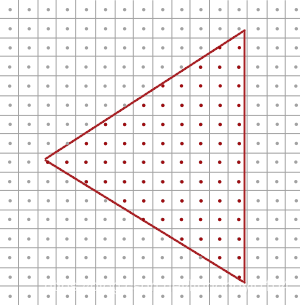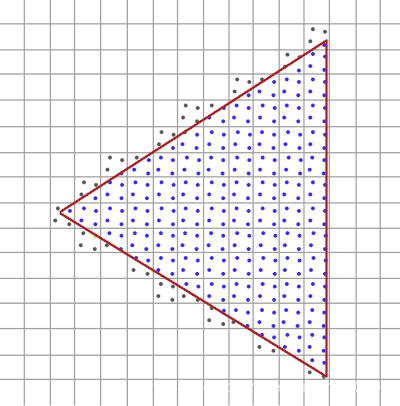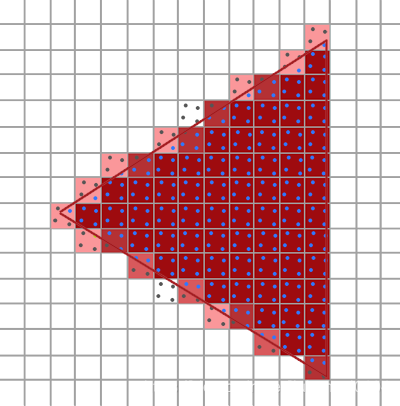一、前言
1. 锯齿
也叫走样(Aliasing),产生原因 ,我们屏幕的分辨率有限,在光栅插值时三角形的边会从像素里穿过,被穿过的像素,无论着色还是不着色,都会产生锯齿。

图片来自 learnopengl

2. msaa的原理
原理比较简单,光栅化时在一个像素里生成更多的样本,计算覆盖率,片元着色器结束后 用覆盖率 乘以像素的颜色,使之显得平滑,不管生成多少样点,shading sample 还是一个样点 shading。


二、forward msaa 的核心步骤
1. 设置 setupMultisampleTarget
创建 颜色 和 深度的 image buffer ,设置 下面结构体VkImageCreateInfo 的VkSampleCountFlagBits ,样本数量取决于具体的硬件,一般是4倍样本,VkSampleCountFlagBits = 4;
2. 设置 setupFrameBuffer
一个framebuffer 关联 4 个 附件的视图,两个是上面的Multisample的附件,两个是单样本的附件。
3. 设置渲染通道
关键是 subpass 的 这个
typedef struct VkSubpassDescription {
VkSubpassDescriptionFlags flags;
VkPipelineBindPoint pipelineBindPoint;
uint32_t inputAttachmentCount;
const VkAttachmentReference* pInputAttachments;
uint32_t colorAttachmentCount;
const VkAttachmentReference* pColorAttachments;
const VkAttachmentReference* pResolveAttachments;
const VkAttachmentReference* pDepthStencilAttachment;
uint32_t preserveAttachmentCount;
const uint32_t* pPreserveAttachments;
} VkSubpassDescription;
这个 结构 会在 片元着色器计算后,framebuffer 阶段 把 pColorAttachments 的附件 解析到 pResolveAttachments 这个附件上,把多样本的image 解析给交换链一个样本的image. 这是自动解析多样本。
三、deferred msaa 的核心步骤
在 deferred 时光栅化时只输出 outPosition outNormal outAlbedo ,并没有做shading,而是转移到 下一个 pass 处理 shading, 所以会有 msaa 和 deferred 冲突。
解决办法 就是 给 输出 outPosition outNormal outAlbedo depth的 image 都设置成 超样本,这个和 forward 时一样。
在fs 做 shading 我们采样在这些保存着多样本的 gbuffer ,手动解析多样本。
sampler2DMS 表示 这是一个多样本纹理 ,要用 texelFetch 去采样。
layout (binding = 1) uniform sampler2DMS samplerPosition; layout (binding = 2) uniform sampler2DMS samplerNormal; layout (binding = 3) uniform sampler2DMS samplerAlbedo;
vec4 resolve(sampler2DMS tex, ivec2 uv)
{
vec4 result = vec4(0.0);
for (int i = 0; i < NUM_SAMPLES; i++)
{
// i 就是每个样本
vec4 val = texelFetch(tex, uv, i);
result += val;
}
// Average resolved samples
return result / float(NUM_SAMPLES);
}
// Calualte lighting for every MSAA sample
for (int i = 0; i < NUM_SAMPLES; i++)
{
vec3 pos = texelFetch(samplerPosition, UV, i).rgb;
vec3 normal = texelFetch(samplerNormal, UV, i).rgb;
vec4 albedo = texelFetch(samplerAlbedo, UV, i);
fragColor += calculateLighting(pos, normal, albedo);
}
fragColor = (alb.rgb * ambient) + fragColor / float(NUM_SAMPLES);
版权声明:本文为CSDN博主「liuhongyi0104」的原创文章,遵循CC 4.0 BY-SA版权协议,转载请附上原文出处链接及本声明。
原文链接:https://blog.csdn.net/liuhongyi0104/article/details/99851801






